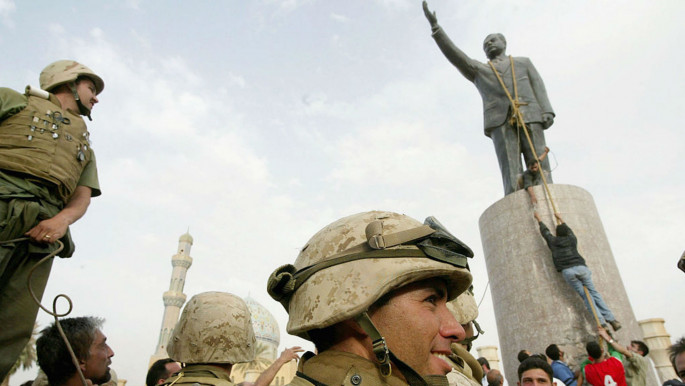Are there any informative historical precedents for a US-Iran war?
Amid fears that recent tensions between the United States and Iran could have resulted in a major war between the two adversaries, it's worth contemplating if there are any informative historical precedents for such a war. It's quite clear upon doing so, however, that there are few, if any, suitable precedents for such an outcome.
Nevertheless, it's worth pondering over precedents from the last few decades to ascertain just how unprecedented such a conflict would be.
Perhaps a fitting precedent, to begin with, is the last, and only, time the US and Iran fought each other. In 1987-88, during the so-called 'Tanker War' phase of the Iran-Iraq War, the US re-flagged and escorted oil tankers through the Persian Gulf to prevent attacks on them from Iran.
Read also: Iran navy rescues sailors following 'tanker attack' off Fujairah coast
Iran's concurrent mining of the sea lanes damaged a US destroyer. The Americans rapidly retaliated, on April 18, 1988, in Operation Praying Mantis by destroying an Iranian British-made frigate and crippling another one in a single day. Tens of Iranian service personnel were killed in the skirmish.
The following August a US missile destroyer infamously shot down an Iranian airliner killing hundreds of civilians. Iran agreed to a ceasefire to end the Iran-Iraq War later the same month.
While the US could certainly decimate Iranian forces in another conventional confrontation like Operation Praying Mantis it's unlikely the Iranians will opt to fight in that manner in any future engagement in the Gulf.
In those days Iran largely used conventional tactics and was, as a result, simply outgunned by the Americans in Operation Praying Mantis. Today, Iran's Islamic Revolutionary Guard Corps (IRGC) paramilitaries rely on asymmetrical warfare tactics and consequently would likely attempt to swarm US naval units with small armed speedboats if there is another confrontation in the Gulf.
 |
All the way back in mid-2002 the US conducted a major war game exercise called Millennium Challenge 2002 that simulated a battle with an unnamed adversary that was likely Iran employing an asymmetrical strategy |  |
All the way back in mid-2002 the US conducted a major war game exercise called Millennium Challenge 2002 that simulated a battle with an unnamed adversary that was likely Iran employing an asymmetrical strategy. The American 'Blue' forces suffered heavy casualties from the Iranian 'Red' forces who used small boats to overwhelm their forces.
 |
|
| Read also: The dangers of destroying Iran's middle class through sanctions |
Ultimately, 'Blue' lost 19 warships including an aircraft carrier, losses which could have killed as many as 20,000 US servicemen in real life. The US military was so embarrassed by this defeat that they controversially restarted the entire game with prepared scripts and new rules to guarantee a US victory, something that real war conditions would not permit for obvious reasons.
The leader of the 'Red' opposition in that simulation, Marine Corps three-star Paul Van Riper bitterly recalled that: "War-gaming is not normally corrupted, but this whole thing was prostituted; it was a sham intended to prove what they wanted to prove."
Another possible precedent for a major confrontation between Washington and Tehran is the 1991 Persian Gulf War between the US-led coalition and Saddam Hussein's Iraq following the latter's invasion and annexation of Kuwait. Overwhelming force and superior technology beat back the enormous Iraqi military and the liberation of Kuwait was swift and decisive.
Also, in that war, the US had the support of an enormous multinational coalition of 35 countries. The United Nations authorised the war, the only such war it had done so since Korea. Furthermore, the then-moribund Soviet Union, which had hitherto supplied Iraq with much of its military hardware, did not oppose the US-led campaign against Baghdad.
In a war against Iran, the US would likely have far less support and will probably have to rely largely on support from Israel and Saudi Arabia, especially if Iran doesn't outright start a conflict like Iraq did in those days with its aggression against Kuwait.
The Gulf War was also the kind of war that the US military likes to fight, hence a straightforward conventional war wherein it can easily bring its superior firepower and technology to bear against its adversary, in that case literally in an open desert battlefield.
Such a confrontation was very different from the kind of war the US would likely have to fight against today's Iran.
And then there was the 2003 invasion of Iraq.
One salient fact others have already noted in comparisons to that conflict is that Iran is a much bigger country with a much larger population than Iraq.
Furthermore, today's Iran, while feeling the brunt of the current round of harsh economic sanctions, is certainly not a basket case like Iraq was in 2003.
Iraq in those days, it's also crucial to remember, was a country which had its military largely destroyed in 1991 and its economy wrecked from a 13-year embargo that saw tens-of-thousands, if not far more, Iraqis perish from lack of food and other basic necessities.
 |
The US has for four decades contemplated various ways it could attack or invade Iran in the event of war |  |
The US has for four decades contemplated various ways it could attack or invade Iran in the event of war. None, however, seriously contemplated anything remotely resembling the 2003 invasion of Iraq and the subsequent occupation of that country.
Even at the height of the Iranian hostage crisis American proposals for attacking Iran never went further than mining its oil ports or capturing either a port or airfield in order to pressure Ayatollah Khomeini.
During the height of the latest tensions, the Department of Defense suggested that the US would need to deploy 120,000 troops to the region if there were to be any confrontation against Iran, and that force would not be for any land invasion. Additionally, anonymous Pentagon officials confided to TIME "that no actual, executable plan, or anything like it, exists for a large-scale troop deployment to the Gulf."
The invasion of broken-backed Iraq consisted of approximately 150,000 US troops along with 45,000 British troops, the only other significant ally the US had in that unpopular war.
It's also worth noting that, when asked if some kind of a military buildup could shape events in Iran in 1980, the exiled Shah of Iran claimed that would take a whopping "760,000 first-class troops." And that was a time when Iran's population was less than half of what it is today.
 |
|
| Read also: America's delusions in Baghdad cost Iraqis their sovereignty |
When the US-led coalition confronted Iraq in 1991, at a time that country had over a million troops and a vast array of military hardware, it did so by deploying a total of 900,000 troops to the region, at least 500,000 of whom were American. And the ground war phase of that war lasted a mere 100 hours before Iraq agreed to a ceasefire.
In its latest standoff with Iran, the US ultimately sent 1,500 additional troops to the region, indicating that it's not seriously preparing for any major confrontation with Tehran.
Israel's airstrikes against nuclear facilities in both Iraq and Syria are often cited when the prospect of war with Iran is discussed.
In an impressive long-range operation, the Israeli Air Force bombed the Iraqi Osirak nuclear reactor in Baghdad on June 7, 1981, without losing a single warplane. For years it was assumed that this setback Iraq's nuclear programme for the proceeding decade until the Gulf War.
However, internal Iraqi documents captured by the Americans following their invasion of the country reveal that this simply was not the case.
As Kenneth Pollack, a former CIA intelligence analyst and Middle East military historian once noted: "Far from setting the Iraqis back on balance the Osirak strike actually accelerated the Iraqi nuclear programme."
Iraq's programme was "moribund" until the Israeli strike, he added, but after that attack "Saddam was so furious and so humiliated that he began pouring money into the nuclear programme."
Pollack expressed his fear that Iran will do something similar if attacked, pointing out that the Iraq precedents are not reassuring given the fact that even though the US bombed Iraq on numerous occasions from the Gulf War up until 2003: "None of that as we understood it turned off his nuclear programme and we wound up invading instead."
The 2007 Israeli strike against a suspected Syrian nuclear reactor, Operation Orchard, has recently been cited as a potential precedent for an Israeli attack on Iran's nuclear programme.
However, Syria is a much closer target for the Israeli Air Force and in that particular case destroying Syria's nuclear ambitions required destroying a single facility. Iran has a much larger nuclear infrastructure and is about three times as far away from Israel.
Additionally, in Operation Orchard the Israelis were able to use Turkish airspace to complete their operation. It's unclear if they could use the airspace of one of Iran's neighbours for such a strike.
Simply put there are barely any useful precedents to inform us what a war between the US, its regional allies and Iran might look like, it would be truly unprecedented.
Paul Iddon is a freelance journalist based in Erbil, Iraqi Kurdistan, who writes about Middle East affairs.
Follow him on Twitter: @pauliddon





 Follow the Middle East's top stories in English at The New Arab on Google News
Follow the Middle East's top stories in English at The New Arab on Google News


